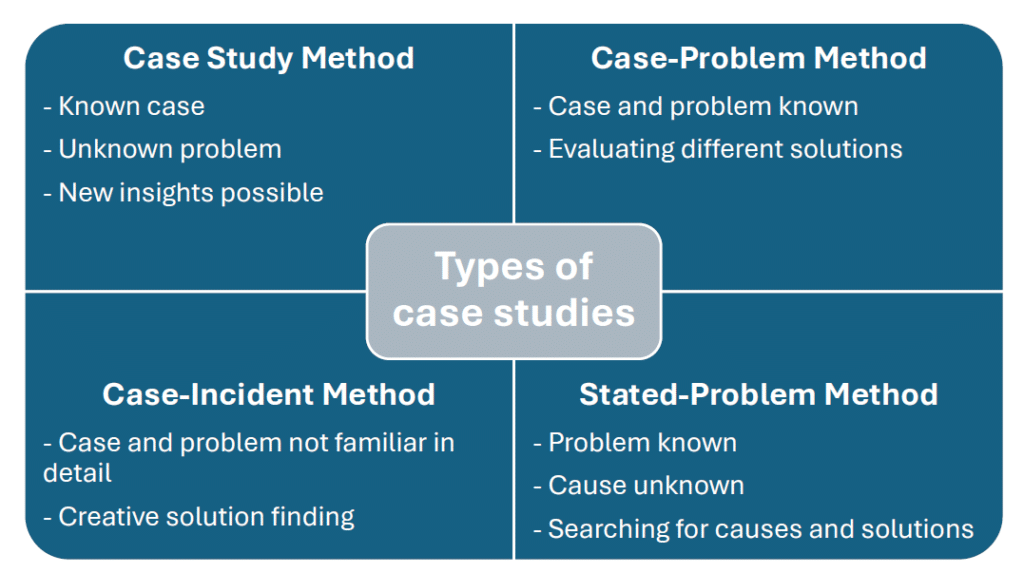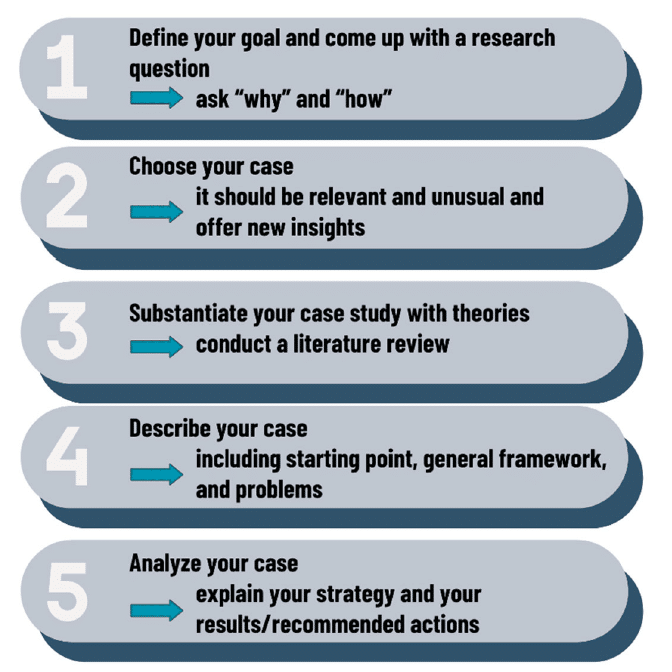First things first:
- A case study examines organizations, people, places or events in order to gain (new) insights into familiar problems or to identify new problems.
- There are four types of case studies: Case-Study-Method, Case-Problem-Method, Case-Incident-Method, and Stated-Problem-Method
- There are five steps in conducting a case study: a research objective, a case, suitable literature, a precise description of your case and a link between your case and existing theories.
What is a case study?
A case study is a research method that is typically used in qualitative research and is often applied in academic papers such as bachelor’s or master’s theses. Having originated from the social sciences, the case study is now used in many other fields such as economics, political science and media studies.
The case study examines a specific example of an event or phenomenon in the real world. All relevant details of the case are thoroughly analyzed, always taking into account the surrounding context and existing theoretical frameworks. If several cases are compared with each other, this is referred to as a comparative case study or a multiple case study.
Objectives and methods of case studies
The main objective of a case study is to gain comprehensive insights into a specific phenomenon and to develop new solutions or perspectives. Both qualitative and quantitative methods are useful for collecting and analyzing relevant data for the case study. Organizations, people, places or events that offer important insights are examined.
Case studies allow you to analyze complex problems in detail, making them an indispensable tool in scientific research.
Case studies: different types and approaches
Depending on your research question, there are different types of case studies you can consider. Each type of case study has its own special features, and the transitions are sometimes fluid. The following paragraphs introduce four common types of case studies to give you an idea of the different approaches:

- Case Study Method: This classic type of case study is often used when you are familiar with a specific case but have not yet identified the hidden problems within it. During your investigation, you will recognize both the challenges and possible solutions. This method helps you to dive deep into the details of the case and gain unexpected insights.
- Case-Problem Method: This type of case study focuses on evaluating different approaches to a solution. You analyze the advantages and disadvantages of each method, evaluate its effectiveness and look for alternatives if necessary. This approach is ideal for case studies that aim to optimize processes or improve strategies.
- Case-Incident Method: This form of case study is often the most challenging as it works with incomplete or missing data. Your task is to create a sound case study despite these limitations. This requires creative methods of data collection and analysis to get a clear picture of the situation.
- Stated-Problem Method: This is the exact opposite of the first methos. You start with a known problem and look for the causes and possible solutions through your case study. This method is particularly useful if you want to explore the deeper roots of a problem.
By choosing the right type of case study, you can ensure that your research is both thorough and focused. Each of these approaches offers different perspectives and methods to arrive at valuable insights that can be explored in detail in the case studies.
How is a case study conducted?
Companies are often looking for a case study that offers a solution to a complex problem. You don’t have to reinvent the wheel. You should simply collect and structure all the relevant information for your case study. At GRIN, you will find numerous case studies that give you a good insight into the structure of this type of text. These practical examples, which are often based on data from real companies, will help you understand how to successfully complete a case study.
The 5 steps of conducting a case study

Define your research objective
Start your case study by first defining a clear research objective and formulating a precise research question. Decide whether your aim is exploratory (discovering), descriptive (describing) or explanatory (explaining/justifying), or a combination of these, to determine your research direction. Since case studies are qualitative research, how or why questions are particularly suitable.
Choose your case
For your case study, you should of course choose an example that is relevant to your research objective. If you are writing about a specific company, you already have the case automatically, but events, people, places or phenomena are also suitable. To choose a suitable example, you can use the following criteria as a guide:
- Take an unusual or atypical example that firstly makes you curious yourself and secondly provides new insights into a known problem.
- The example should critically question existing assumptions or theories.
- Ideally, your case should open up new approaches for future research.
Link your case study to existing theories and literature
Once you have defined your research objective and case for your case study, the next step is to link it to existing literature and the current state of research. Conduct a comprehensive literature review to compare your findings with relevant thematic texts.
To create a solid theoretical framework, draw on an appropriate theory that allows you to understand and explain the case in depth. When analyzing your results, you can then discuss how they behave in the context of this theory and what they say about the topic.
Describe your case study
Once you have finished researching existing theories and literature, start describing your case in detail. If it is an event, a timeline can be helpful, showing all the important events along with their causes and effects. The aim is to clearly differentiate your case study from other studies and research questions.
An important part of the case study is the description of the initial situation, the framework conditions and the problems to be solved. It is essential that your (possibly fictitious) customer recognizes themselves in the description. Be authentic and use the technical vocabulary of the respective industry. This increases the relevance of your case study.
Analyze the case
The final step in your case study is to comprehensively analyze the collected data. Evaluating and explaining this information will allow you to answer your research question. You can embed your findings in a broader theoretical context by drawing connections to existing literature and theories that you identified during your literature review.
In this section of your case study, you also explain how you analyzed the situation, what kind of strategy you developed and how you implemented it operationally. It is also important to mention any problems and obstacles you encountered.
Analysis tools for solving a case study
When working on business case studies in particular, there are a number of models, so-called frameworks, that can be of great help. Which framework is suitable for which problem depends on the type of case study. These can basically be divided into three categories:
External problem
This example focuses on external factors: e.g. the market environment of the company under investigation. The five forces model and the PESTEL analysis are suitable for identifying and analyzing such research areas.
Internal problem definition
Internal company issues are considered here, e.g. low employee satisfaction. The value chain analysis or the BCG matrix are suitable for such internal analyses.
Internal and external problems
Most case studies examine external and internal problems in equal measure, as mixed cases are often considered, e.g. a decline in a company’s sales. These cases can be analyzed using the profit equation, the four-C concept, the SWOT analysis, or the Ansoff matrix.
Checklist: Case study for companies
Case studies for companies always follow the same structure. You can therefore use this checklist as a guide:
- Title of the case study: What is it about in a nutshell?
- Introduction of the company: Who is the case study aimed at?
- Problem/research question: What is it about (specifically), what are the current challenges and what should be changed?
- Facts: What does the company offer? What is the market and market environment like? Which target group should be addressed?
- Results: What follows from the facts analyzed?
- Graphics: Graphical representations are always good for case studies. Present the facts in table form, create diagrams and add them to your continuous text. This will enhance your study.
- Solution: What specific recommendations for action do you give to the company you have analyzed?
Key Takeaways
A case study is a research method that allows you to analyze specific cases such as organizations, people, or events from different perspectives and relate them to existing theories.
This method is particularly valuable for bachelor’s and master’s theses, as it provides in-depth insights into the research topic.
The goal of a case study is to understand and explain a specific case by analyzing it in detail and linking it to existing theories identified during the literature review.
This method helps to answer open questions and develop solutions to existing problems.
You will conduct a case study in five steps: you define your research goal, select a case, find suitable literature and theory, describe the case, and analyze it by examining it comprehensively and linking it to existing theories.
Choosing a case study has a few advantages: You can investigate a real case that interests you, which makes your study more relevant.
Case studies also require less organizational effort than interviews or surveys, and can uncover previously unknown problems or questions that are of interest for further research.
And another advantage: Case studies are used in many companies in the application process to test applicants.
If you have already gained experience with it during your studies, this can be an advantage for you later on.
A good case study must definitely be relevant to your study.
In addition, it should provide new insights into a known problem, critically question existing assumptions and open up new approaches for future research.
Examples for case studies in the GRIN shop:
Do you like our magazine? Then sign up for our GRIN newsletter now!











